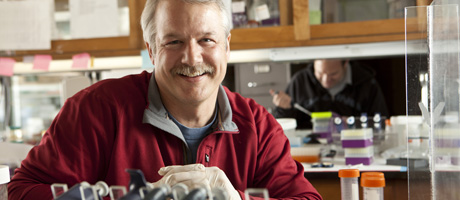Researchers from the George Washington University and Boston University School of Medicine have developed a method to rapidly identify pathogenic species and strains causing illnesses, such as pneumonia, that could help lead to earlier detection of disease outbreaks and pinpoint effective treatments more quickly. The findings are featured online in the journal Genome Research.
Emerging sequencing technologies have revolutionized the collection of genomic data for bioforensics, biosurveillance and for use in clinical settings. However, new approaches are being developed to analyze these large volumes of genetic data. Principal investigator Evan Johnson, assistant professor of medicine at BUSM, and Keith Crandall, director of GW’s Computational Biology Institute, have created a statistical framework called Pathoscope to identify pathogenic genetic sequences from infected tissue samples.
This unique approach can accurately discriminate between closely related strains of the same species with little coverage of the pathogenic genome. The method also can determine the complete composition of known pathogenic and benign organisms in a biological sample. No other method can accurately identify multiple species or substrains in such a direct and automatic way. Current methods, such as the standard polymerase chain reaction detection or microscope observation, are often imperfect and time-consuming.
“Pathoscope is like completing a complex jigsaw puzzle. Instead of manually assembling the puzzle, which can take days or weeks of tedious effort, we use a statistical algorithm that can determine how the picture should look without actually putting it together,” Dr. Johnson said. “Our method can characterize a biological sample faster, more accurately and in a more automated fashion than any other approach out there.”
This work will be relevant in a broad range of scenarios. For example, in hospitals, this sequencing method will allow for rapid screening of thousands of infectious pathogens simultaneously, while being sensitive enough to monitor disease outbreaks caused by specific pathogenic strains. Veterinarians can even apply the method in their practices.
This research is also applicable outside of clinical settings, allowing officials to quickly identify agents of bioterrorism (e.g., in a tainted letter) and harmful pathogens on hard surfaces, soil, water or in food products.
“This approach has the ability to drastically change the process for identifying and combating pathogens, whether they’re in a hospital, veterinarian’s office or salmon stream,” Dr. Crandall said.
Researchers plan to conduct more studies to further verify the efficacy of their approach, and will soon begin to work with the aquaculture industry, helping fishermen with water-quality surveillance.


